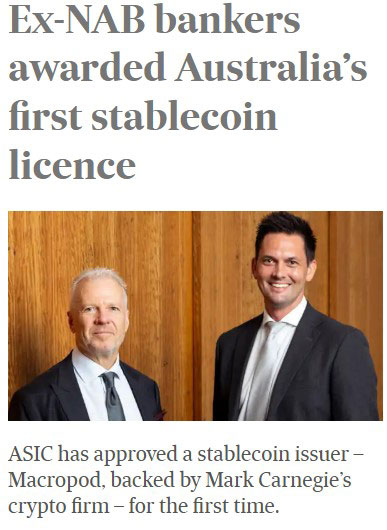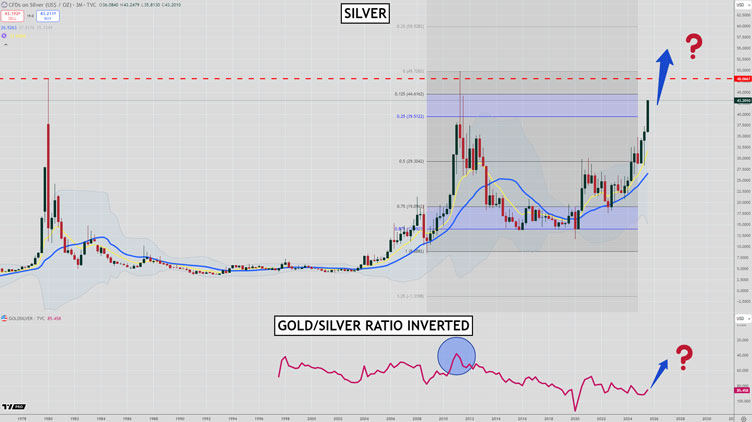Last week, Australia quietly awarded its first stablecoin licence to Macropod, a company founded by former NAB bankers:

Source: AFR
To most investors, this might seem like a minor regulatory milestone.
It’s not.
This is a signal of what’s to come for the global financial system.
And it is clear we are now fast entering a period of what I call techno-monetary competition.
This is where the major powers increasingly use technologies of value as extensions of foreign policy.
Strategic moves to box out competitors now play out in the global financial system.
The implications for Australian investors are significant.
The stablecoin battleground
Think of stablecoins as digital versions of traditional currencies, designed to maintain stable value by being backed by reserves.
Their real power lies elsewhere.
They’re programmable, can move across borders at light speed, and operate outside traditional banking infrastructure.
And the numbers tell the story of why governments are paying attention so closely.
Stablecoin market capitalisation has grown at a compound annual rate of 77% over five years, reaching more than $250 billion.
In 2024 alone, stablecoin transfer volume surged to $27.6 trillion.
That’s more than Visa and Mastercard combined.
Let that sink in for a second…
This isn’t just about financial innovation advancing at breakneck speed.
It’s about control over the future plumbing of global commerce.
China’s digital currency weapon
Beijing understands this strategic reality better than most world powers, developing yuan-backed stablecoins as part of its broader challenge to US dollar dominance in international trade.
The digital yuan experiment tells the story.
Cumulative transactions of $7.3 trillion represent more than just technological advancement.
It’s a geopolitical weapon designed to reduce global reliance on dollar-dominated financial infrastructure.
Every transaction chips away at American monetary hegemony.
The American response
The United States isn’t sitting idle while competitors build alternative systems.
The GENIUS Act passed in July 2025 creates a comprehensive regulatory framework requiring dollar-backed stablecoins to be fully backed by US dollars and short-term Treasury instruments.
Issuers face stringent oversight requirements.
This matters because it legitimises stablecoins as formally recognised components of the US financial system, with projections indicating market capitalisation could exceed $3 trillion by 2030.
More importantly, it ensures global stablecoin adoption happens on American terms.
Using sweet, sweet US dollars.
This is the foundation for future demand for US Treasury securities.
The strategic calculus is crystal clear to Washington policymakers.
Dollar stablecoins combine the currency’s global liquidity with the security of blockchain-based ownership, circumventing capital controls while circulating freely between digital wallets worldwide.
Unlike conventional money, they move without asking permission.
Australia caught in the middle
For Australia, this emerging landscape creates both opportunity and significant challenge. Our recent regulatory moves position us as a potential leader in the Asia-Pacific region for stablecoin innovation.
Imagine iron ore contracts settling in AUD stablecoins?
But Australia faces a delicate balancing act that could define our economic future.
As a resource-exporting nation with deep trade ties to China, we must navigate the growing divide between US-led financial systems and China’s expanding digital currency networks.
The stakes couldn’t be higher.
And our economic interdependence with both superpowers makes neutrality difficult.
The introduction of Australian dollar stablecoins like AUDM represents more than domestic financial innovation.
It’s about maintaining monetary sovereignty in an increasingly digital world.
When other countries’ digital currencies become the default for international trade, they gain influence over pricing, settlement terms, and ultimately economic policy.
Control the money, control the game.
The investment implications
The advent of increased techno-monetary competition creates several investment themes that savvy investors should be watching closely.
First, expect accelerated adoption of blockchain-based payment systems across traditional finance as banks and payment networks integrate stablecoins to remain competitive.
Major institutions can no longer afford to ignore digital payment rails offering 24/7 settlement, lower costs, and global reach.
Second, the infrastructure supporting this new monetary system becomes increasingly valuable as institutional adoption accelerates.
Companies involved in custody, cybersecurity, and blockchain infrastructure are positioned to benefit.
This extends beyond pure crypto plays to traditional financial technology companies adapting to the new landscape.
The risks are real
This transition toward digital monetary systems isn’t without serious dangers that could reshape geopolitics overnight.
The same technologies enabling faster, cheaper payments also create new vulnerabilities.
Cyberattacks on digital currency infrastructure could represent violations of digital sovereignty, akin to acts of war.
And privacy concerns around government-issued digital currencies are legitimate, particularly given their potential for more comprehensive surveillance.
I think the next five years will determine whether the current dollar-dominated international monetary system evolves or gets replaced by something fundamentally different.
China’s aggressive push into digital currency infrastructure may represent a serious challenge to Western financial dominance.
Meanwhile, the West’s response through regulated stablecoins and CBDCs will shape whether democratic values get embedded in the future of money.
For Australian investors, this means staying informed about regulatory developments and understanding how currency digitisation affects everything from international trade to portfolio construction.
The companies and countries that master these technologies first will have significant advantages in the global economy that emerges.
So yes, the stablecoin wars have begun.
The question isn’t whether digital currencies will reshape global finance.
The question is who will control the infrastructure when they do.
Regards,

Lachlann Tierney,
Australian Small-Cap Investigator and Fat Tail Micro-Caps
***
Murray’s Chart of the Day – Silver

Source: Tradingview
Silver is taking off like a rocket as expected after the breakout above US$35 in June.
When you step back and look at 50 years of data and consider the gold/silver ratio there is the prospect of much more upside.
In the chart above you can see the last two times silver approached $50.
The first time was in 1980 when the Hunt brothers tried to corner the silver market.
The equivalent price in today’s dollars is close to US$200!
The next time was in 2011 at the last major peak in gold and silver before a serious bear market that lasted nine years.
The chart above has the gold/silver ratio with the scale inverted in the lower pane.
I have circled the area where the gold/silver ratio was trading at the last peak in 2011.
At the time the gold/silver ratio was around 40. It dipped even lower than that during the final spike in the silver price to US$50.
At the current gold price a gold/silver ratio of 40 would give silver a price of US$92.32.
So you could make a case that silver still has a lot of catching up to do, especially if the gold price keeps running.
How silver performs within the current major sell zone between US$39-45 will be telling.
If it slices through US$45 like butter we may be witnessing a rally that is only getting started.
Regards,

Murray Dawes,
Retirement Trader and International Stock Trader




Comments